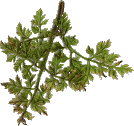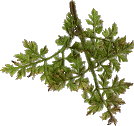The National Chervil Board |
Growing your own chervil can be an extremely rewarding experience. Despite its exotic reputation, it is no harder to grow chervil than any number of other soft herbs, like basil or parsley. You can grow it indoors or out, climate permitting, and like most herbs, chervil is a renewable resource, so you never need to go without.
You will probably not be able to find chervil seeds at your local hardware store, supermarket or greenhouse. If you ask, you are likely to get a blank stare. Mind you, there are SOME places that stock chervil seeds (and chervil plants), but most of us are not lucky enough to have such outlets in our neighborhoods. If you do, get your seeds from them.
Chervil is a green herb, like cilantro, basil or parsley, not a woody herb like thyme or rosemary. This means it is usually raised as an annual and planted each spring (and often in mid-summer for a fall crop). This means it likes sun and can be damaged by frost.
The seeds are tiny. Plant them about 1/8" deep in well worked soil. They will take from two to four weeks before you start seeing little green things. When they are 2" or so, thin them out a bit. Each plant needs about 8" - 10" of space. According to Burpee, it is a good idea to soak the seeds in water for 24 hours before planting so they will germinate better.
You can start eating chervil as soon as you pick it. When you thin the plants, you get your first crop. You can then trim leaves or branches as you please. As summer progresses, the plant will bolt and grow taller. The stalk will thicken and little white flowers will bloom. You can still keep harvesting, just throw out the stalks and keep the tender stuff.
Chervil can actually reseed itself, so you will often find little chervil plants coming up on their own late in the growing season or at the start of the next growing season. This is an advantage of a non-hybrid plant.
 |
  |
 |